Laptop Mag Verdict
The Galaxy Note 20 Ultra is the most refined and powerful Android smartphone of 2020, but it comes at a pretty hefty price.
Pros
- +
Versatile camera with excellent video
- +
Vibrant 6.9-inch 120Hz display
- +
Solid battery life
- +
Improved S Pen
- +
Most powerful Android processor
Cons
- -
Pricey
- -
Huge camera bump
- -
Facial recognition fails at times
Why you can trust Laptop Mag
Price: $1,299 or $1,449
OS: Android 10 with One UI 3.0
Display: 6.9-inch Super AMOLED WQHD+, 120Hz
CPU: Qualcomm Snapdragon 865+
RAM: 12GB LPDDR5
Rear cameras: 108MP wide (ƒ/1.8); 12MP telephoto with 5x optical zoom (ƒ/3.0); 12MP ultrawide (ƒ/2.2)
Storage: 128GB or 512GB
Battery: 10:26
Size: 6.48 x 3.04 x 0.32 inches
Weight: 7.33 ounces
The Galaxy Note is traditionally one of the most powerful Android devices released each year, targeting power users who want the best. This year’s Galaxy Note 20 Ultra is no exception. While more experimental form factors like the Galaxy Z Fold 2 or Microsoft Surface Pro Duo command a higher price point, none deliver pure top-of-the-line specs to match the Galaxy Note 20 Ultra.
From the massive 6.9-inch Super AMOLED, 120hz display, to the Snapdragon 865 Plus processor and 108-megapixel camera, there is nothing lacking in the Note 20 Ultra’s specs list. So the question is whether Samsung manages to harness those specs into a solid user experience that warrants the $1,299 starting price?
I’ve spent the last two weeks putting the Galaxy Note 20 Ultra through its paces and I’m ready to help you figure out if it should be your next smartphone.
Samsung Galaxy Note 20 Ultra price and configurations
The Galaxy Note 20 Ultra starts at $1,299 and, while that is unquestionably expensive, it is slightly less so than the Galaxy S20 Ultra and the Galaxy Z Fold 2, at $1,399 and $1,999, respectively. Going with the Note 20 Ultra is positively thrifty by comparison.
I reviewed the base model of the Galaxy Note 20 Ultra on Verizon, which includes 128GB of storage and 12GB of RAM and, while it does feature a microSD slot that supports up to 1TB, if you want more native storage, you can upgrade to the 512GB model for $1,449.
Samsung Galaxy Note 20 Ultra design
While it's not perfect, the overall design of the Galaxy Note 20 Ultra is absolutely beautiful. The Mystic Bronze might be a little ostentatious for some tastes, but there’s no arguing that it makes a statement. If you prefer something more subdued, the phone is also available in Mystic Black and Mystic White.
With the gently curved edges of the display, perfectly squared-off edges and a metallic back, the Note 20 Ultra offers a refined look. It transcends the rounded rectangles that we have become accustomed to on most traditional smartphones and possibly beats Apple to the punch with its upcoming iPhone 12 design revision.
Sign up to receive The Snapshot, a free special dispatch from Laptop Mag, in your inbox.
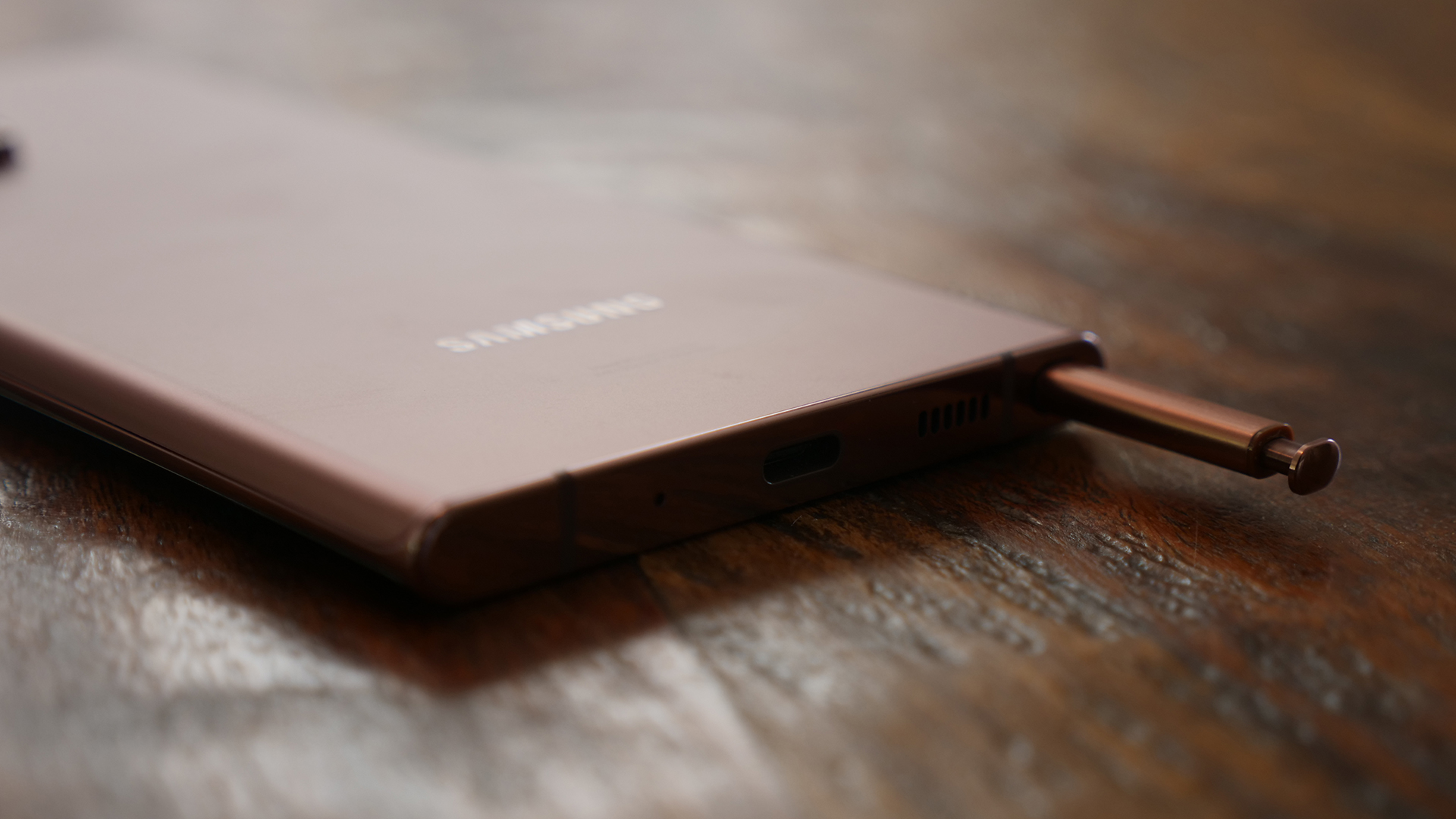
Regardless of how pleasing I think that waterfall display looks, I don’t love it from a usability standpoint. At times, it makes for frustrating touch targets on the edges of the screen and it picks up random taps or swipes if I’m not careful with my hand placement. I suspect over time I’ll adjust, but if you aren’t coming from a device with a waterfall display, be prepared for slight growing pains at the outset.
Turning to the back of the device, I encountered one of my biggest quibbles with the Ultra’s design –– the massive camera bump. Now I’ll cover the quality of those lenses later in the review, but the degree to which they stick out from the back of the phone is problematic. The placement along the edge of the phone makes it all the worse as it is impossible to lay the phone flat on a surface and use it.
The obvious answer is to simply add a case, but that, of course, obscures the outstanding design. While Samsung couldn’t have gotten away with making the Note 20 Ultra thick enough to eliminate the camera bump, it could have added a bit more thickness to its 0.3-inch frame to reduce it or centered the bump to avoid the wobble.
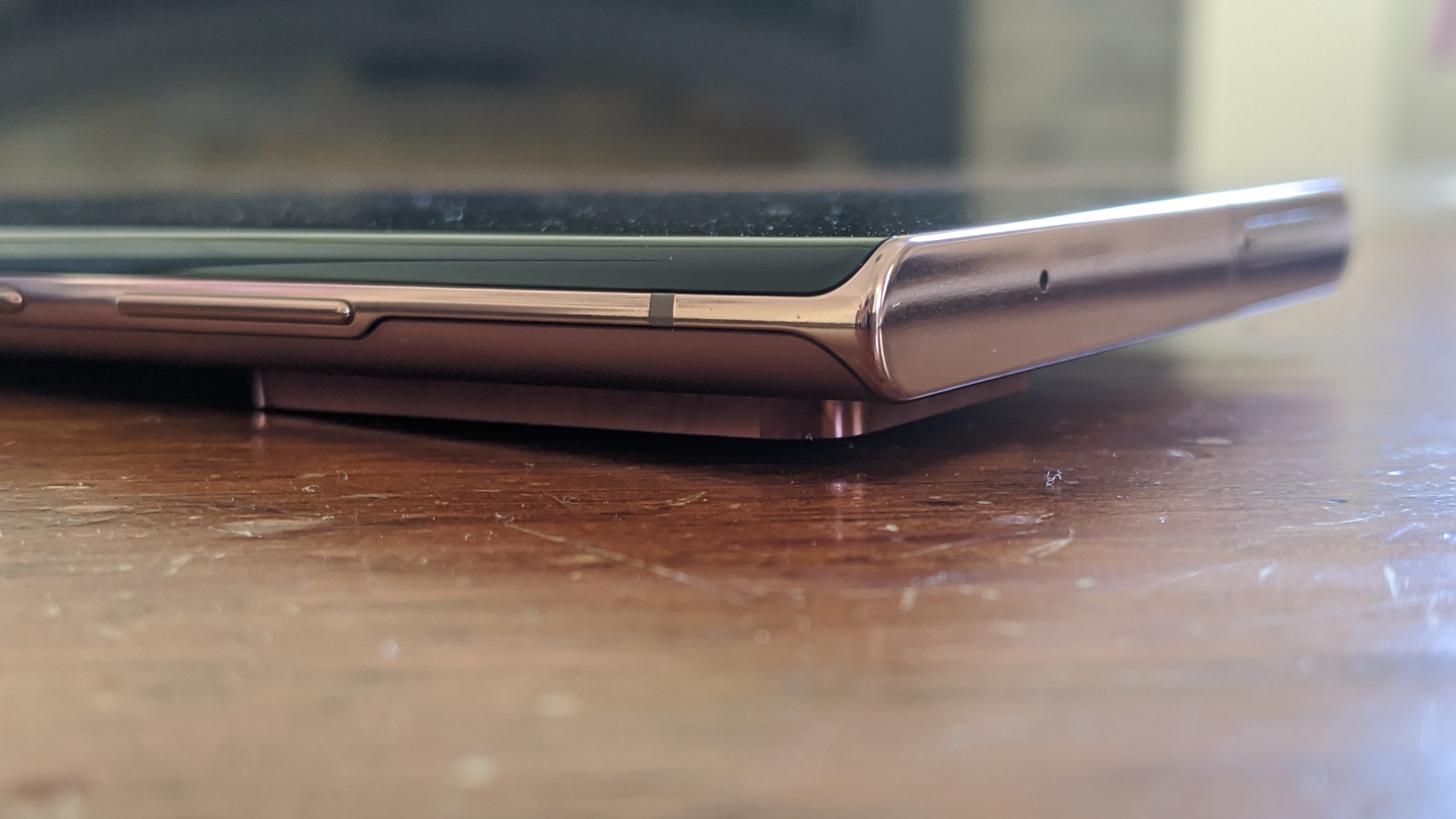
The Galaxy Note 20 Ultra measures 6.5 x 3 x 0.3 inches and weighs 7.3 ounces. It’s a large device to be sure, but it’s slightly shorter and thinner than the Galaxy S20 Ultra, which makes it a little easier to manage despite the identical 6.9-inch display sizes.
The matte finish on the Note 20 Ultra avoids the fingerprint magnet issue of glossier smartphones. Even after a couple of weeks with the phone it showed virtually nothing.
The Galaxy Note 20 Ultra is a gorgeous smartphone that sets itself apart from most traditional devices, but I can’t imagine carrying it daily without a case.
Samsung Galaxy Note 20 Ultra ports
As with most modern smartphones, the ports on the Galaxy Note 20 Ultra aren’t exactly plentiful. However, you do get more than just the standard USB Type-C. Your bonus port is a microSD slot accessible via the SIM tray. It will allow you to bump up the native 128GB or 512GB of storage by up to 1TB.
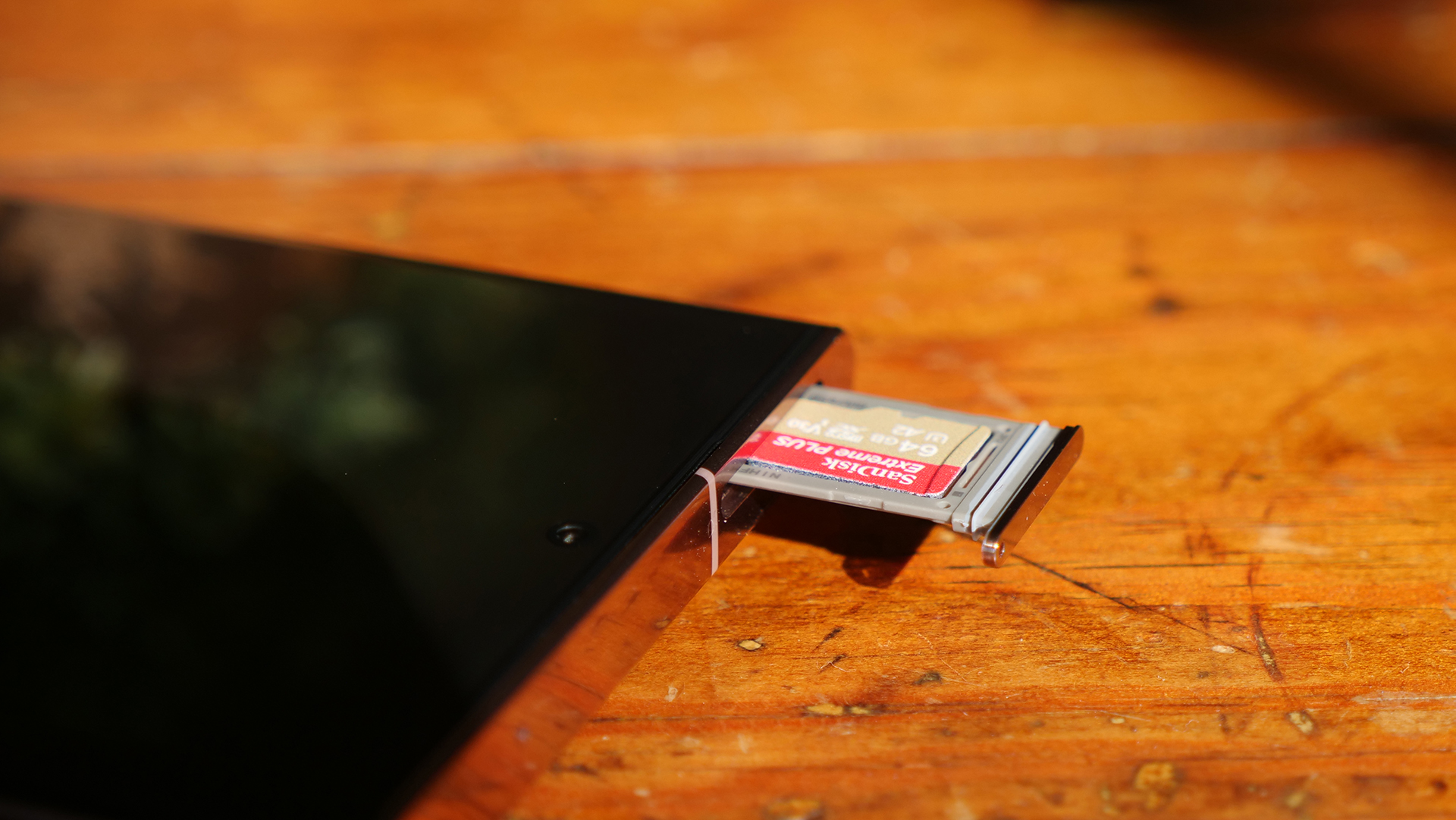
Samsung Galaxy Note 20 Ultra display
The Galaxy Note 20 Ultra’s vivid 6.9-inch, Super AMOLED display is easily among the best on the market with its WQHD+ (3088 x 1440 pixels) resolution and the new dynamic 120Hz refresh rate.
That last piece is critical. Similar to the panels on the Galaxy S20 lineup, the Note 20's 120Hz display results in silky smooth animation and scrolling was excellent. On the Galaxy S20, you had to manually switch the screen between 60hz and 120hz if you wanted to use the full resolution (120Hz is limited to 1080p) or the more battery-friendly 60Hz mode. With the new Adaptive mode, the phone switches automatically depending on the content. So you get 120Hz only for relevant content and 60Hz on just about everything else. However, if you’re viewing static content, the rate can drop even further.
The combination of the 120Hz refresh rate with the 240Hz touch sampling rate makes the Note 20 Ultra feel fantastically responsive. There’s no perceptible delay in the UI as you move from screen to screen and, if you like gaming on your smartphone, there’s no question this is one of the best options.
Not all games support 120Hz, but there’s over 200 and the list is growing faster now that Samsung has brought it to the mass market. I tested it out on a handful of titles, including Mortal Kombat, Dead Trigger 2, 1945 Air Force and Alto’s Odyssey. The smooth performance never faltered and elevates all of these games regardless of genre and art style.
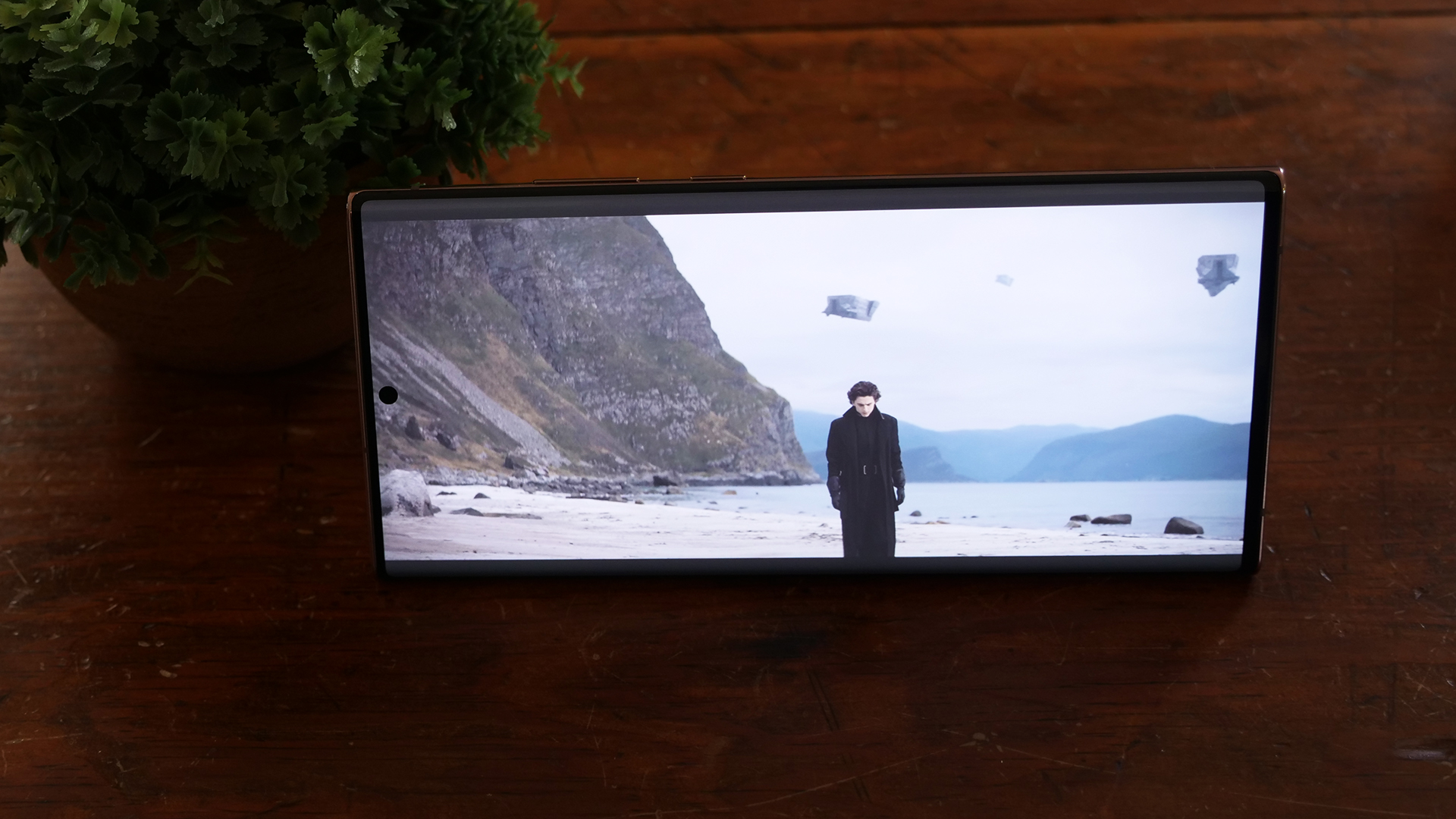
Watching video content is similarly a joy on the Ultra thanks to the high resolution 6.9-inch display and its HDR support. I watched the 1080p HDR trailer for Dune and the dark visuals remained easy to parse, especially the deep blacks of Paul Atreides costume.
As with the Microsoft Surface Duo, the Ultra offers a pair of options for the display: vibrant and natural. It will be a question of personal preference, but in our testing, the vivid mode delivered 201% of the sRGB color gamut while the natural came in at 122%. While natural comes up shy of the 139% average for smartphones, it bests the iPhone 11 Pro Max (119%) and the vivid setting comes in only slightly behind the Galaxy Z Fold 2 (206%).
Feel free to use the Ultra in direct sunlight as we recorded its average brightness at 663 nits. It’s not nearly as luminous as the iPhone 11 Pro (752 nits), but is among the top contenders nonetheless.
Overall, I can’t say enough positive things about the Ultra’s display. It will draw the best out of whatever content is on screen and holds up well in almost any viewing environment.
Samsung Galaxy Note 20 Ultra S Pen
I have to be honest and say that, while I have owned a few Notes over the years, I have never been an avid user of the S Pen in part because my handwriting is atrocious. However, I know plenty of users who absolutely swear by it. For those people, Samsung has stepped up its game with the S Pen in recent years, adding slick features such as the reduced 9-millisecond response time.
That last piece is particularly notable as it drops from the 42ms response time on the previous S Pen, which makes a night and day difference. Like the 120Hz refresh rate on the display, it not only offers a smoother interaction, but it also gives you a stronger sense of interacting directly with the device.

The S Pen and its related software have picked up some tricks in recent years. For example, Air Gestures, which allow you to navigate your device by waving the S Pen in the air, has some legitimately great uses this time around. The simplest is using it as a remote trigger for your camera, snapping a photo or switching between the front and rear-facing cameras without touching your phone.
Digging a little deeper, the Samsung Notes app has a feature that makes the Ultra a potentially perfect device for taking notes. Now you can embed a voice note in your handwritten notes and it will highlight what you wrote as the voice note playback. That way, if you missed something or, in my case, you can’t figure out what on earth you wrote, just jump back to that point in your notes to find out what was said.
As I said at the outset, I am not the perfect candidate for the handwriting component of the S Pen, but even if that is the case for you, the stylus can be a useful accessory without ever taking a single note with it.
Samsung Galaxy Note 20 Ultra audio
While there are naturally limits with any smartphone, for its size, the Ultra’s bottom-mounted speakers can get pretty loud. The integrated speakers easily filled my medium-sized testing space. But while it delivers clear audio, the low-end is lacking. The Dolby Atmos support and Dolby Atmos for gaming software can be used to augment the audio in addition to the built-in EQ settings.
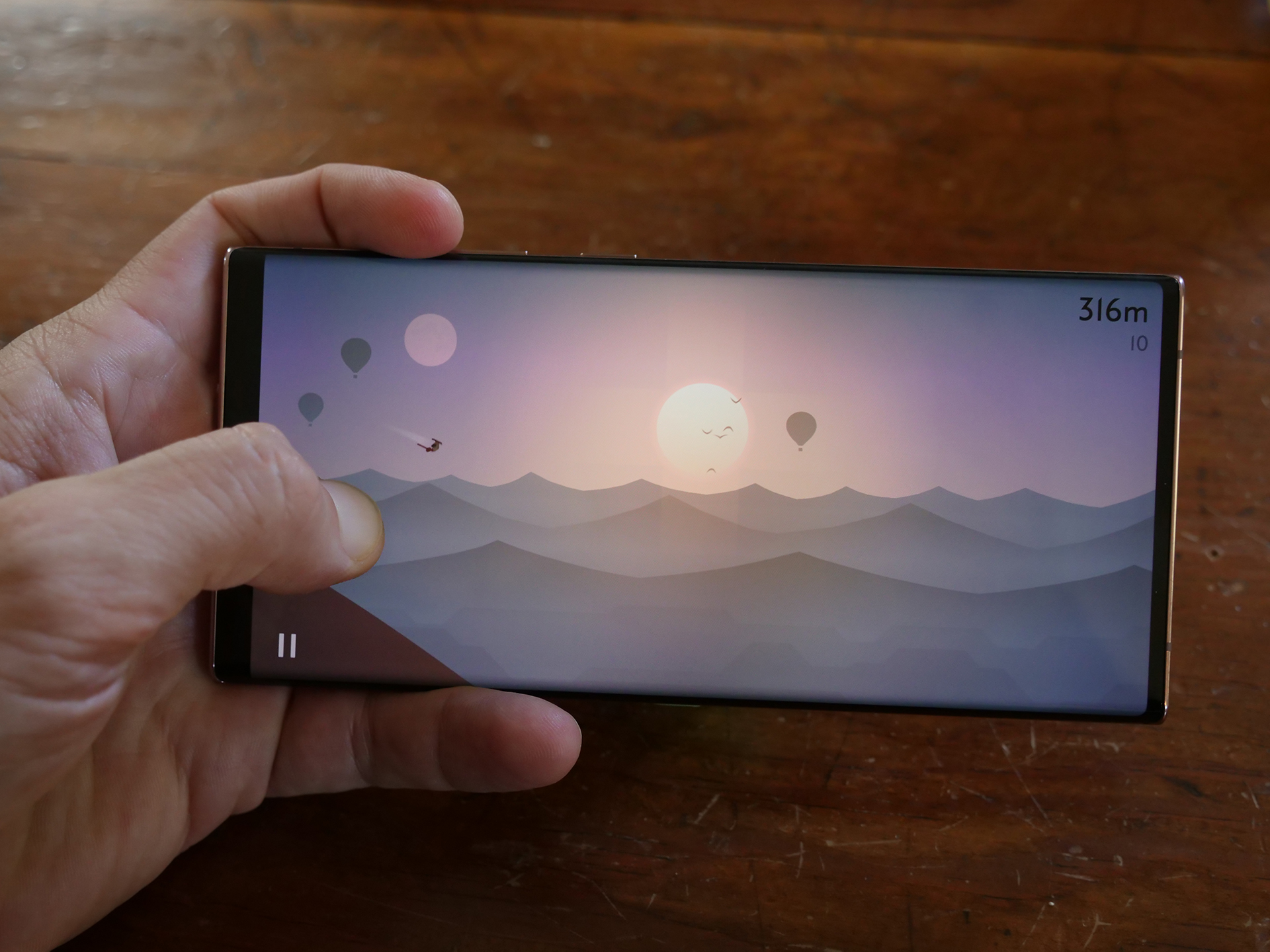
The speakers’ directional audio made me aware of encroaching zombies in Dead Trigger 2 before they got too close to attack. And when I played Alto’s Odyssey, the subtle sound of the board sliding on the sand wasn’t overwhelmed by the atmospheric background music.
Listening to Future Islands’ “Moonlight” the Note 20 Ultra’s speakers were well suited to the subtle bass and mellow instrumentation while keeping the layered vocals crisp and clear. Although the audio is better than average, you’d still be better served by a good pair of wireless headphones
Samsung Galaxy Note 20 Ultra performance
Those who passed on the Galaxy S20 lineup earlier in the year to wait for the updated Note are being rewarded with the latest and greatest from Qualcomm: the Snapdragon 865+. While it isn’t a quantum leap from the Snapdragon 865 CPU found in the Galaxy S20, according to Qualcomm, it delivers a 10% improvement in both graphics and clock speed. It’s irrefutably the pinnacle of Android chipsets at the moment.
With 12GB of RAM, the Galaxy Note 20 Ultra has plenty of memory available to juggle dozens of Google Chrome tabs while having a Netflix show playing in picture-in-picture without a stutter. As previously mentioned, gaming is amazing on the Ultra, even for games that don’t support 120Hz. PUBG Mobile for example, plays flawlessly even at its highest settings.
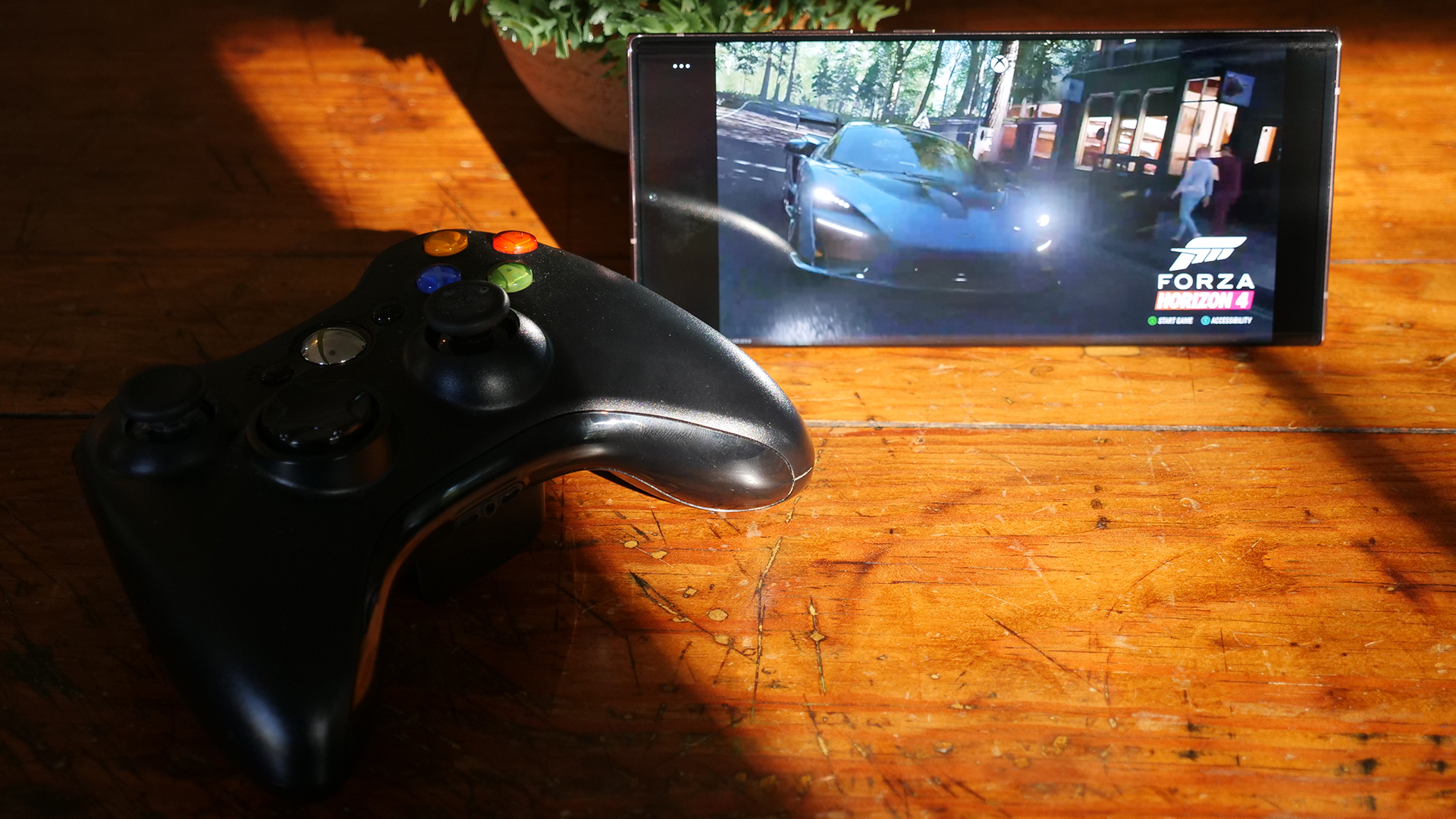
Looking to our benchmarks for further support, the Note 20 Ultra put up one of the highest Geekbench 5 multi-core scores that we’ve seen, at 3,294. But it was just behind the gaming focused Asus ROG Phone 3 (3,393) and the A13-powered iPhone 11 Pro (3,500).
GFXBench 5.0 specifically looks at graphics performance. The Ultra delivered a result of 1,455 frames on the Aztec Ruins in High Tier Off-Screen; It’s a good score, but not enough to overtake the iPhone 11 Pro’s 1,657 frames.
In our Adobe Premiere Rush video editing test, the Ultra took 1 minute and 16 seconds to finish rendering a set task. The iPhone 11 Pro completed the job in 0:45.
Like the Galaxy S20 lineup, the Ultra supports both mmWave and sub-6Ghz 5G.While the networks are still somewhat limited, you’re covered on all fronts as 5G continues to become more relevant across the country.
Samsung Galaxy Note 20 Ultra battery life
The Galaxy Note 20 Ultra cedes the title of biggest battery in a Galaxy smartphone this year to the Galaxy S20 Ultra. However, it still offers a solid 4,500 mAh that easily powered me through the day.
A typical day of usage during my review period includes about an hour of Netflix, 3-4 hours of YouTube Music (film scores are my typical writing companions), 30 minutes to an hour of Xbox Game Pass, and a mix of Twitter, general web surfing, Slack and email that probably amounts to 1.5 hours of usage. Most days, I would have roughly 15% to 20% battery life remaining by the time I dropped the phone back on its wireless charger at around 10 p.m.

Our lab test produced a similar result. The Ultra lasted 10 hours and 27 minutes on our battery test, which consists of continuous web surfing over Verizon’s 5G network at 150 nits of brightness and 60Hz. However, the time noticeably dropped when we switched to 120Hz as the phone only lasted 7:59.
The Galaxy S20 Ultra and iPhone 11 Pro Max lasted longer with times of 11:58 and 11:54, respectively.
When it’s finally time to charge the Ultra, the bundled 25-watt charger can get you a 30% charge in just 15 minutes and juice all the way to 56% within half an hour.
Samsung Galaxy Note 20 Ultra cameras
With that massive collection of lenses on its back, you'd hope the Ultra is going to at least take good photos. For the most part, I found that to be true, but there are some odd exceptions.
The Galaxy Note 20 Ultra features three lenses, the 108MP, f/1.8 primary lens is a wide-angle lens. There’s also a pair of 12MP lenses for ultrawide (ƒ/2.2) and telephoto (ƒ/3.0). A new laser focus was also introduced to clear up some of the focusing issues Galaxy S20 users experienced.
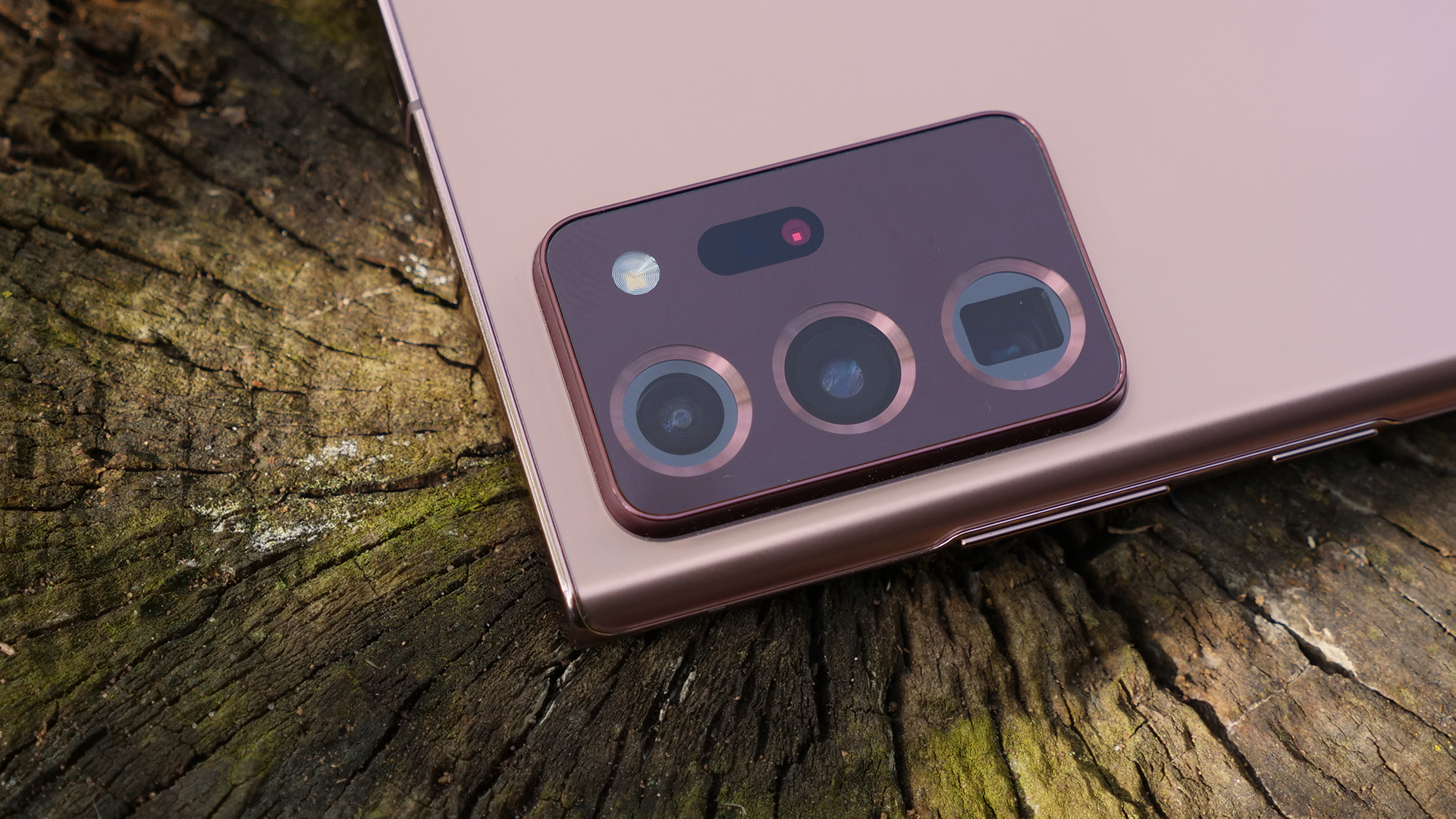
Switching between the three lenses is done by tapping on the corresponding icons along the right side of the camera app, which gives you a 0.5x, 1x and 5x zoom. Once you tap on any of these (or if you hold down and slide up or down), you can go through incremental zoom steps all the way up to a whopping 50x zoom.
Here’s a gallery of what that zoom range actually looks like. Things start to fall off pretty hard at around 20x zoom. Samsung wisely didn’t go for the 100x zoom found on the Galaxy S20 Ultra, but even the 50x seen here is essentially only a novelty. If you are looking to produce an image to actually share, you probably need to stay within 10x zoom, which is still astounding for a smartphone.

Galaxy Note 20 Ultra 0.5x zoom

Galaxy Note 20 Ultra 1x zoom

Galaxy Note 20 Ultra 5x zoom

Galaxy Note 20 Ultra 20x zoom

Galaxy Note 20 Ultra 50x zoom
The massive zoom isn’t the only trick the Note 20 Ultra has up its sleeve. If you opt to take a full 108MP image, you lose the ability to zoom in optically as it has to use that wide-angle primary lens. However, you can easily crop and zoom after the fact with all of those pixels. So if you aren’t 100% sure what part of a scene you want to capture, this will keep your options wide open (no pun intended).
Samsung still overdoes it with color saturation at times. In this sample, the petals of this flower are quite pink, but not the nearly eye-searing pink the Ultra captured. I had issues with blurring around the edges of the images when using anything beyond the 5x optical zoom. This is distinct from the software produced and natural bokeh you get in portrait images.

While it isn’t quite equal to what you get with the Pixel 4 or the iPhone 11 Pro Max, the bokeh produced in Samsung’s portrait shots are quite good. My complaint with it is that it has a tendency to apply a little too much smoothing and, at times, wash out faces. It’s not always a problem, but in more complex lighting situations, it can struggle.

Speaking of lighting, the Ultra’s Night Mode can’t match the best from Google and Apple. However, it’s much closer than with previous Galaxy Note generations. Even in a nearly completely dark environment, you will get usable shots of static items and marginal lighting will make shots of people serviceable without resorting to a flash.
Video is one area where Samsung has really upped its game this year. Now only Apple retains an edge on the Ultra, which can capture up to 8K video at 24 frames per second or 4K at up to 60 frames per second and 1080p at 120 frames per second for awesome slow-motion playback. Pro Video mode gives you more extensive controls over video capture with granular control over zoom speed, focus, white balance, exposure and more. Audio controls will allow you to direct the built-in mics on the smartphone or you can capture audio from external mics or earbuds, like the Galaxy Buds Live.
Samsung Galaxy Note 20 Ultra software and warranty
The Galaxy Note 20 Ultra is currently running Android 10 with Samsung’s One UI version 2.5. Updates to One UI version 3.0 as well as Android 11 are in the works. We just don’t have a specific timeline yet. While Samsung hasn’t always been timely with Android updates, it has pushed out security updates recently and committed to updating the Galaxy Note 20 Ultra through Android 13.
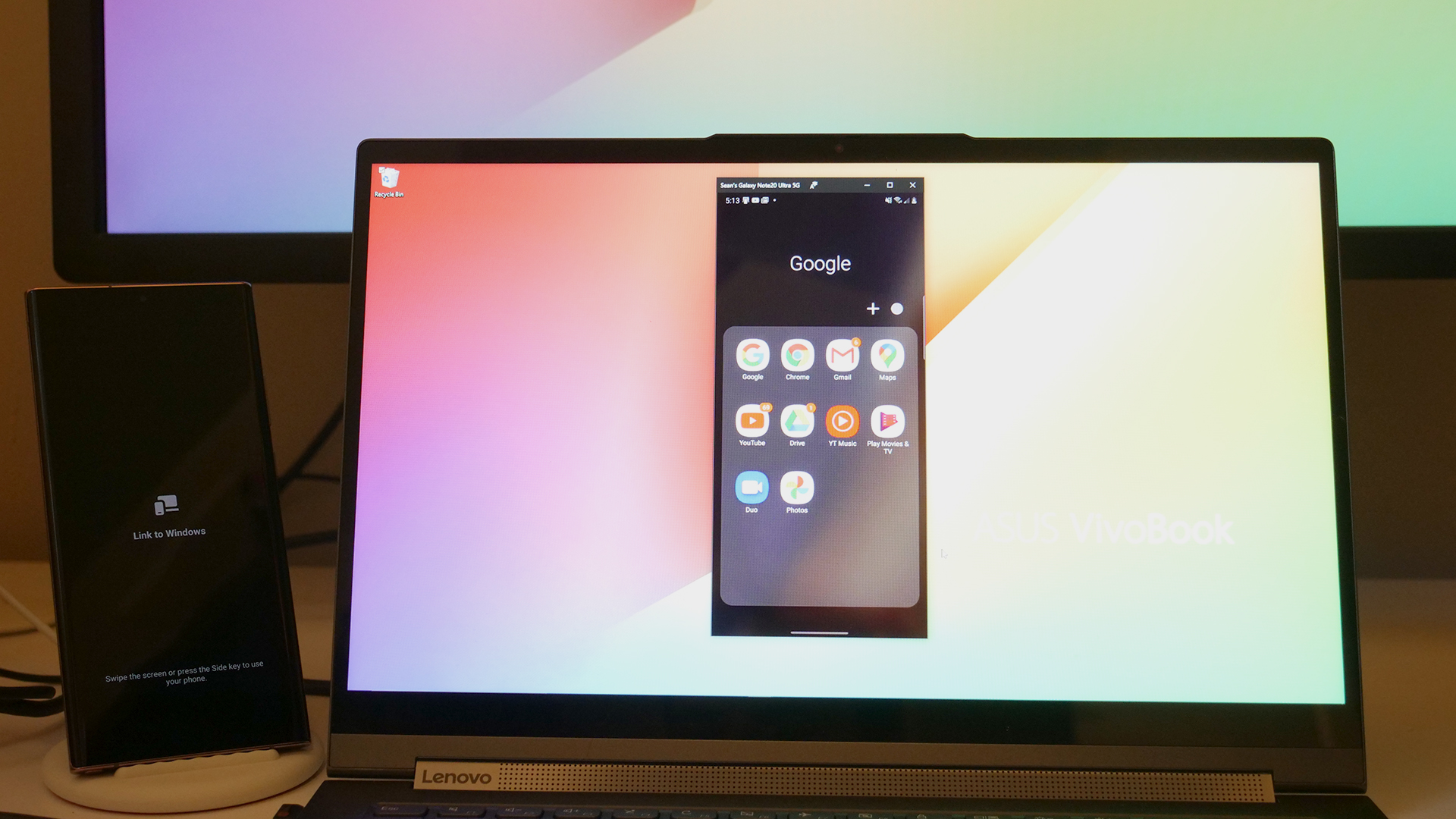
Samsung delivers a couple of unique software features with its smartphones, including DeX, which is essentially a desktop interface you can run from your Galaxy Note 20 Ultra. Now it is entirely wireless if you have a TV with Miracast (unfortunately I do not). The basic idea is that you screencast your smartphone to the TV and can navigate the operating system using the screen of your Note 20 Ultra as a touchpad.
Additionally, the Galaxy line enjoys more robust integration with Windows 10 than most Android devices. Rather than requiring the Your Phone Companion app on your Ultra, you simply pull down the Quick Settings shade and tap Link to Windows to get started. Once you connect your PC you have all of the features that other Android phones have on Windows 10 like the photo gallery, calls and texts. You also can stream your Android screen directly to your Windows 10 PC meaning you can leave your phone plugged in and handle everything from your laptop.
The Galaxy Note 20 Ultra comes with a one-year limited warranty. Check out our Best and Worst Brands and Tech Support Showdown reports to find out how Samsung fared this year.
Bottom line

The Galaxy Note 20 Ultra isn’t perfect, but it is unquestionably one of the best smartphones of 2020 and delivers a solid experience on nearly every front. Despite my minor quibbles, the Ultra has one of the most versatile camera setups out there and can produce photos and videos that you’ll be thrilled to share.
Features like the 120Hz display are fantastic and with Adaptive mode, you can enjoy it on the Note 20 Ultra without sabotaging your battery life, which is exactly the sort of refinement Note fans have waited for.
There are still a handful of high-profile devices coming this year, like the iPhone 12 and Pixel 5, but the Note 20 Ultra sets a high bar for them to try to clear.
Sean Riley has been covering tech professionally for over a decade now. Most of that time was as a freelancer covering varied topics including phones, wearables, tablets, smart home devices, laptops, AR, VR, mobile payments, fintech, and more. Sean is the resident mobile expert at Laptop Mag, specializing in phones and wearables, you'll find plenty of news, reviews, how-to, and opinion pieces on these subjects from him here. But Laptop Mag has also proven a perfect fit for that broad range of interests with reviews and news on the latest laptops, VR games, and computer accessories along with coverage on everything from NFTs to cybersecurity and more.


